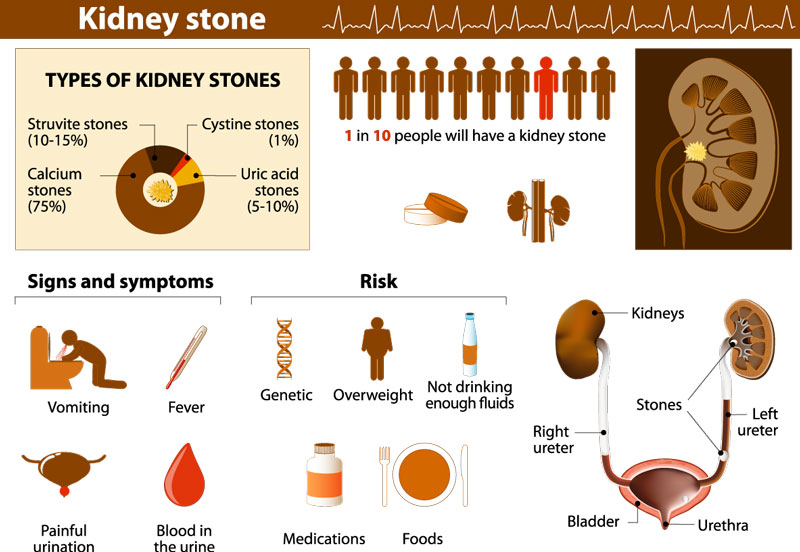Kidney Stones
What are kidney stones?
Kidney stones or calculi are solid collections of normal urinary components which have precipitated out of the urine to form crystals. The majority of stones are calcium-based but there are several other types of stones which can also occur. Kidney stone formation is often influenced by diet, fluid intake, heredity, and occasionally other medical problems. Stones are more common in men and are believed to affect roughly 5-10% of the population.
What are the symptoms of kidney stones?
Kidney stones can be asymptomatic if they are in the kidney and not causing any obstruction. As stones move around in the kidney, they may intermittently cause pain, also known as renal colic. When stones move out of the kidney and into the ureter and begin moving down toward the bladder, they may get stuck along the way and cause obstruction of the kidney. This causes the kidney and ureter to stretch which can cause severe pain, nausea, and vomiting. Stones can also lead to urinary tract infections, blood in the urine, and stones that are in the lower part of the ureter near the bladder can cause urinary frequency and urgency.

Stone Disease
In this video, Dr. Michael Herzog, a stone expert in Chicagoland and Northwest Indiana, discusses stone pain and presents the reasons why testing stones is an important step you should do with your urologist. Learn these important follow up facts about stone disease, including kidney stones, bladder stones and other urological stone diseases. See why having one stone may not be your last.
How are kidney stones diagnosed?
A strong suspicion of a stone can be made based on the history and symptoms, but imaging of the urinary tract is required to make a definitive diagnosis. Plain x-rays are simple, inexpensive, and often can show the location of a stone. Some stones, however, are too small to be seen on x-ray and some types of stones are not visible on regular x-rays. Ultrasound can also be utilized and often provides information not only on the presence of stones in the kidney or upper part of the ureter but also if the kidney is swollen from obstruction (hydronephrosis). Ultrasound, however, often misses small stones, especially those in the mid to lower part of the ureter. The best imaging modality for the diagnosis of kidney stones is a non-contrast CT scan. While this does utilize more radiation, it provides the most information about the size and location of stones and the anatomy of the kidneys and ureters. CT scanning is also fast and readily available.
How are stones treated?
Many stones are able to pass all the way out of the urinary tract without any intervention. When stones are symptomatic in the ureter, medical expulsion therapy can be utilized. This is often accomplished with an alpha-blocker such as tamsulosin and these medications help to relax the smooth muscle in the ureter to aid in stone passage. The alpha-blocker may be combined with an anti-inflammatory like ibuprofen and occasional steroids are also used to help decrease inflammation and swelling in the ureter to aid in stone passage.
Larger symptomatic stones that do not pass, require some type of intervention. One option that is often used in the emergent setting is to place a ureteral stent which is a small tube between the kidney and bladder that allows the urine to drain around an obstructing stone. For stones in the kidney or upper part of the ureter, shock wave lithotripsy (SWL) can be used to fragment the stone. This is an outpatient, non-invasive procedure that uses sound waves to fragment the stone into tiny fragments that can then pass on their own. Another option is to perform a ureteroscopy during which a small scope is placed into the ureter and under direct visualization, the stone is removed with a small basket device or a laser (laser lithotripsy) is used to break the stone into smaller pieces which can then pass. For very large stones, sometimes a percutaneous procedure is required. During a percutaneous stone extraction, a small tube is placed directly into the kidney from the back and a scope is placed directly into the kidney and the stone is then broken up with either an ultrasound device or a small pneumatic device (like a jackhammer) and the stone fragments are suctioned out. Unlike the other procedures, a percutaneous procedure requires an overnight hospital stay.
Ureteroscopy and laser lithotripsy is a minimally invasive, outpatient procedure that can treat a wide variety of kidney stones regardless of what type of stone or location.
Extracorporeal shock wave lithotripsy (ESWL) is a kidney stone treatment that is minimally invasive or non-invasive and uses sound waves to break up stones from outside the body.
For larger kidney stones, sometimes a percutaneous nephrolithotomy (PCNL) is preferred where a telescope is placed directly into the kidney and the stones are broken up and suctioned out all through a tiny incision in the back.
How do I prevent stones?
The most common causes of stone formation are dehydration and excess salt (sodium) intake. Therefore, most patients will benefit from drinking more fluids and decreasing the amount of salt in their diet. After stones are treated, especially in patients with recurrent or multiple stones, a metabolic evaluation is performed to determine what other risk factors are present that may be able to be corrected with dietary modifications or medications. The metabolic evaluation includes a simple blood test and a 24-hour urine collection.

